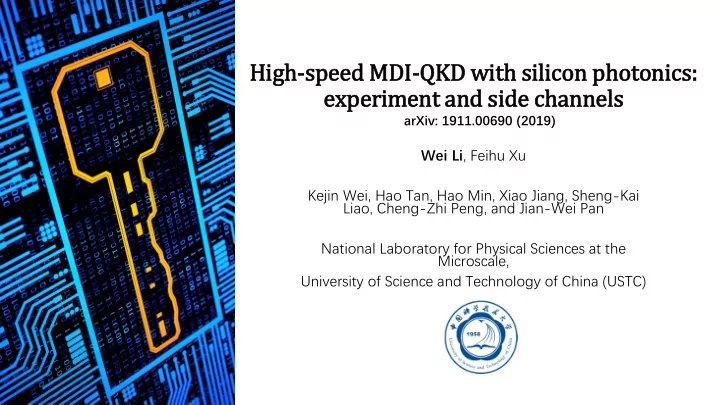

Hig igh-speed MDI-QKD with ith sil ilicon photonics: experiment and sid ide channels arXiv: 1911.00690 (2019) Wei Li , Feihu Xu Kejin Wei, Hao Tan, Hao Min, Xiao Jiang, Sheng-Kai Liao, Cheng-Zhi Peng, and Jian-Wei Pan National Laboratory for Physical Sciences at the Microscale, University of Science and Technology of China (USTC)
QKD networks • C. Elliott, arXiv: quant-ph/0503058 (2005). U.S. • M. Peev et al., New J. Phys. 11, 075001 (2009). Europe • T.-Y. Chen et al., Opt. Express 18, 27217 (2010). China • M. Sasaki et al., Opt. Express 19, 10387 (2011). Japan Fig. a • B. Frohlich et al., Nature 501, 69 (2013). • R. J. Hughes et al., arXiv:1305.0305 (2013). Fig. b QKD networks with untrusted relay is needed
Chip-based QKD Si InP • • P. Sibson et al., Nat. Commun. 8, 13984 (2017). C. Ma et al., Optica 3, 1274 (2016). ( Transmitter, BB84 ) • P. Sibson et al., Optica 4, 172 (2017). ( COW, BB84 ) ( COW, BB84, DPS ) • • D. Bunandaret al., PRX 8, 021009 (2018) ( BB84 field test ) H. Semenenko et al., Optics Letters 2, 44 (2019). • C. Agenesiet al., Optics Letters 2, 44 (2019). ( Laser for MDI ) ( Laser for MDI ) • • G. Zhang et al., Nat. Photonics 13, 839 (2019). H. Semenenko et al., Optica 7, 238 (2019). ( MDI, ( Continuous variable ) concurrent with our work ) Integration is inevitable for future developments
Chip ip-based MDI-QKD network BSM • Enhanced security: untrusted relay • Low cost: mass production • Scalable: star-type topology • Chip: transmitter only, free of loss
GHz chip ip-based MDI-QKD se setup • 1.25 GHz chip-based MDI-QKD with random modulations • Si chip integrates all the encoding components for transmitter K. Wei*, W. Li* et al., arXiv: 1911.00690 (2019), accepted by PRX.
Experimental l chall llenges 1.25 GHz modulation High-visibility independent laser sources Injection locking & optical filter 0.484 • Four independently adjustable levels • 10 GSa/s, 7.5 Vpp • DC coupled
Sta table le operation a b Polarization stability Wavelength stability over 70 km fiber Stable operation with minimum maintenance c QBER Mode Maintenance Polarization Yes Time Yes Wavelength No Intensity No
Lab view The transmitter is ready Detecting system to be enclosed in a shoebox-size chassis Chip transmitter Driving circuit
Result lt Reference Clock Channel Secret finite-key rate(MHz) loss(dB) key rate(bps) 10 -3 Tang et al., 2016 10 2.0 25 Tang et al., 2014 75 9.9 67 10 -9 Commandar 2016 Valivathi et al., 20 16.0 100 Asymptotic 2017 Yin 2016 10 -10 Yin et al., 2016 75 19.5 1380 Tang 2014 Valivathi 2017 Comandar et al., 1000 20.4 4567 10 -10 Tang 2016 2016 Ours 1250 20.4 6172 10 -10 28.0 268 10 -10 Fastest MDI-QKD system and highest reported key rates
Securit ity lo loophole les • Side channels in high-speed QKD • Side channels in chip-based QKD
Patt tterning eff ffect t on modula lati tion Pattern average intensity deviation from s → 𝐲 of second pulse s → s 1.000 - μ → s 1.002 0.24% υ → s 1.003 0.32% 0 → s 1.003 0.27% s → μ 0.617 - μ → μ 0.626 1.51% υ → μ 0.610 -1.08% 0 → μ 0.632 2.44% s → υ 0.029 - μ → υ 0.027 -5.57% υ → υ 0.025 -11.95% 0 → υ 0.027 -5.90% Intensity deviation is less than 12% K.-i. Yoshino et al., npj Quantum Inf. 4, 8 (2018).
Patt tterning eff ffect: modulator + dri rivin ing si signal 𝛗 100 mV deviation Carrier depletion modulator 18 GHz @3 dB DC coupled is better than AC coupled
Securit ity lo loophole les • Side channels in high-speed QKD • Side channels in chip-based QKD
Trojan Horse att ttack Time-bin encoding transmitter reflectivity: -42.87dB Lucamarini et al., Phys. Rev. X 5, 031030 (2015). Reflectivity of our chip is smaller
QKD against Troja jan Horse att ttack Experiment data Chip-based MDI-QKD Chip-based BB84 protocol MDI-QKD is more vulnerable to Trojan Horse attack K. Tamaki et al., New Journal of Physics 18, 065008 (2016).
Oth ther si side channels • Polarization dependent loss Less than 0.8 dB • Intensity fluctuation Less than 0.04 dB • Phase randomization T. Kobayashi et al., Phys. Rev. A 90, 032320 (2014). Solution? K. Tamaki et al., Phys. Rev. A 90, 052314 (2014). M. Pereira et al., npj Quantum Inf. 5, 62 (2019).
Summary • Silicon photonic chip-based MDI-QKD • 1.25 GHz random modulation • Highest secret key rate • Side channels are characterized K. Wei*, W. Li* et al., arXiv: 1911.00690 (2019), accepted by PRX. • Patterning effect • Intensity fluctuation • Trojan Horse attack • Phase randomization • Polarization dependent loss
Acknowledgement Funding Prof. Feihu Xu Prof. Jian-Wei Pan Thank you for your attention! Email: weil@ustc.edu.cn
Recommend
More recommend